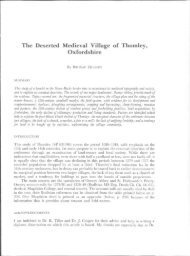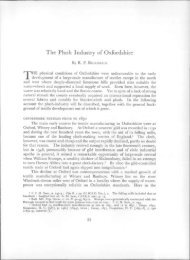Excavations at Wallingford, 1974 - Oxoniensia
Excavations at Wallingford, 1974 - Oxoniensia
Excavations at Wallingford, 1974 - Oxoniensia
Create successful ePaper yourself
Turn your PDF publications into a flip-book with our unique Google optimized e-Paper software.
"6.00ml A<br />
ODN -I<br />
EXCAVATIONS AT WALLINGFORD, <strong>1974</strong><br />
NOR TH - SOUTH SEC TlON (A- C)<br />
THROUGH THE BELL PIT<br />
B<br />
•<br />
I" Ch"lk&Flint 221<br />
---------_ .c::=J_<br />
/j<br />
Present ground "<br />
level<br />
i<br />
I<br />
o<br />
Sc .. le<br />
W<strong>at</strong>er table<br />
(1"'~:~~\<br />
1m<br />
Dark stony soil<br />
227<br />
;;0----,<br />
-<br />
Soil tinged red<br />
-small<br />
stones<br />
Layer of large<br />
flints + ash<br />
. e '" •••• • : •<br />
:',_:e'.' ..• '<br />
N<strong>at</strong>ural gravel<br />
PIG. 6<br />
North-south section through the bell-pit in trench II.<br />
. ?Fired<br />
Hf--+t--'-' cl~<br />
Dark<br />
soil<br />
According to Theophilus the basic steps in the process were as follows:<br />
(I) construct Ihe bell mould<br />
(2) dig the pit<br />
(3) lay a found<strong>at</strong>ion of stones in the base of the pit<br />
(4) back fill the pit<br />
(5) place the bell mould over the centre of the pit and re-excav<strong>at</strong>e the pit, thereby<br />
lowering the mould on to the found<strong>at</strong>ion<br />
(6) construct a kiln around the mould and fire it<br />
(7) when firing is complete quickly remove the kiln surround and fill the space<br />
between the mould and the pit wall with earth to support the mould<br />
(8) raise the cast bell by reversing the steps in 5.<br />
The fact th<strong>at</strong> the pit was first dug (in the n<strong>at</strong>ural gravel) and then back filled to lower<br />
the mould explains the thickness of earth between the n<strong>at</strong>ural gravel (the original pit)<br />
and the darkened pit lining (the re-excav<strong>at</strong>ed pitl-see FIG. 6. The layer of large flints<br />
found in the bottom presumably formed the found<strong>at</strong>ion on which the bell mould rested.<br />
The lining of the pit was blackened by the he<strong>at</strong> from the kiln. No trace of the kiln or bell<br />
mould was found. According to Theophilus' both would have been removed completely<br />
from the pit before the mould was broken to release the bell.













